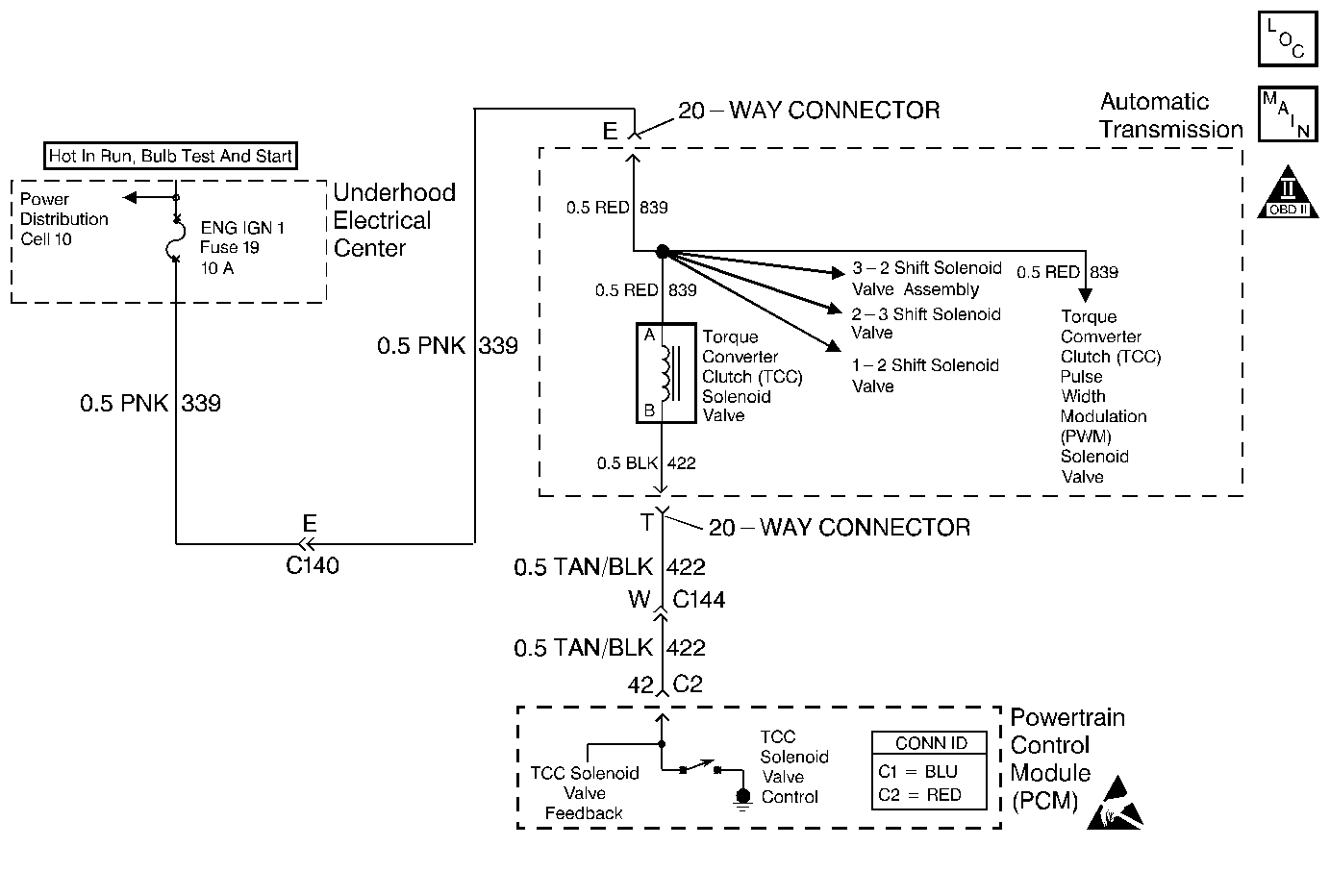
Circuit Description
The torque converter clutch (TCC) solenoid valve is an electrical device that is used with the torque converter clutch pulse width modulation (TCC PWM) solenoid valve in order to control TCC apply and release. The TCC solenoid valve attaches to the transmission case assembly extending into the pump cover. The TCC solenoid valve receives ignition voltage through circuit 339. The powertrain control module (PCM) controls the solenoid by providing the ground path on circuit 422. The PCM monitors the throttle position (TP) voltage, the vehicle speed and other inputs in order to determine when to energize the TCC solenoid valve.
When the PCM detects a continuous open or a short to ground in the TCC solenoid valve circuit or in the TCC solenoid valve, then DTC P0740 sets. DTC P0740 is a type B DTC.
Conditions for Running the DTC
| • | The system voltage is 8-18 volts. |
| • | The engine speed is greater than 300 RPM for 5 seconds. |
| • | The engine is not in fuel cutoff. |
Conditions for Setting the DTC
DTC P0740 sets if either of the following conditions occurs for 5 seconds:
| • | The PCM commands the solenoid ON and the voltage input remains high (B+). |
| • | The PCM commands the solenoid OFF and the voltage input remains low (0 volt). |
Action Taken When the DTC Sets
| • | The PCM illuminates the malfunction indicator lamp (MIL) during the second consecutive trip in which the Conditions for Setting the DTC are met. |
| • | The PCM inhibits TCC engagement. |
| • | The PCM inhibits 4th gear if the transmission is in hot mode. |
| • | The PCM freezes shift adapts from being updated. |
| • | The PCM stores DTC P0740 in PCM history during the second consecutive trip in which the Conditions for Setting the DTC are met. |
Conditions for Clearing the MIL/DTC
| • | The PCM turns OFF the MIL during the third consecutive trip in which the diagnostic test runs and passes. |
| • | A scan tool clears the DTC from PCM history. |
| • | The PCM clears the DTC from PCM history if the vehicle completes 40 warm-up cycles without an emission-related diagnostic fault occurring. |
| • | The PCM cancels the DTC default actions when the fault no longer exists and the ignition switch is OFF long enough in order to power down the PCM. |
Diagnostic Aids
| • | Inspect the wiring at the PCM, the transmission connector and all other circuit connecting points for the following conditions: |
| - | A backed out terminal |
| - | A damaged terminal |
| - | Reduced terminal tension |
| - | A chafed wire |
| - | A broken wire inside the insulation |
| - | Moisture intrusion |
| - | Corrosion |
| • | When diagnosing for an intermittent short or open condition, massage the wiring harness while watching the test equipment for a change. |
| • | With the TCC engaged, the TCC slip speed should be -20 to +40 RPM. |
Test Description
The numbers below refer to the step numbers on the diagnostic table.
-
This step tests for voltage to the solenoid.
-
This step tests the ability of the PCM and wiring to control the ground circuit.
-
This step tests the resistance of the TCC solenoid valve and the automatic transmission (A/T) wiring harness assembly.
Step | Action | Value(s) | Yes | No | ||||||||
|---|---|---|---|---|---|---|---|---|---|---|---|---|
1 | Was the Powertrain On-Board Diagnostic (OBD) System Check performed? | -- | ||||||||||
2 |
Important:: Before clearing the DTC, use the scan tool in order to record the Freeze Frame and Failure Records. Using the Clear Info function erases the Freeze Frame and Failure Records from the PCM. Are any of the following DTCs also set?
| -- | ||||||||||
3 |
Refer to Wiring Repairs in Wiring Systems. Was a short to ground condition found? | -- | ||||||||||
Is the test lamp ON? | -- | |||||||||||
5 |
Important: The condition that affects this circuit may exist in other connecting branches of the circuit. Refer to Electrical Diagnosis for complete circuit distribution. Repair the open or short to ground in ignition feed circuit 339 (PNK) to the TCC solenoid valve. Refer to Wiring Repairs in Wiring Systems. Is the repair complete? | -- | -- | |||||||||
Does the test lamp turn ON when the TCC solenoid valve is commanded ON, and OFF when commanded OFF? | -- | |||||||||||
7 |
Refer to General Electrical Diagnosis in Wiring Systems. Refer to Wiring Repairs in Wiring Systems. Was an open, short to ground or short to power condition found? | -- | ||||||||||
Is the resistance within the specified range? | 21-33 ohms | |||||||||||
9 | Replace the PCM. Refer to Powertrain Control Module/Throttle Actuator Control Module Replacement in Engine Controls. Is the replacement complete? | -- | -- | |||||||||
10 | Measure the resistance between terminal E and ground, and between terminal T and ground. Are both readings greater than the specified value? | 250 K ohms | Go to Diagnostic Aids | |||||||||
11 | Replace the A/T wiring harness assembly (this includes the TCC solenoid valve). Refer to Torque Converter Clutch Pulse Width Modulation Solenoid, Torque Converter Clutch Solenoid, and Wiring Harness Replacement. Is the replacement complete? | -- | -- | |||||||||
12 | Perform the following procedure in order to verify the repair:
Has the test run and passed? | -- | System OK |
